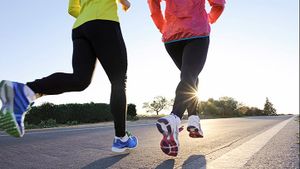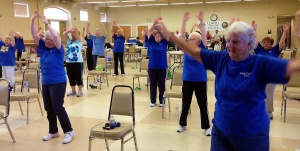Physical Activity as an Anti-Aging Medicine
Original Editor - Tolulope Adeniji
Introduction[edit | edit source]
Chronic conditions is prevalent in older adults as a result of impact of ageing on body system. Some of this decline is considered normal ageing while chronic conditions that is prevalent among this population also compound their health outcome.
- Common condition in older adults such as neurocognitive disorder, osteoarthritis and cardiovascular diseases impair or reduce their activity level and further predispose them to sedentary associated diseases.
- Recently there is growing interest in Physical activity and exercise to improve functions, remediate or alleviate impairments in this population.
This paper will identify potential physical activity and exercises that capable or reversing or alleviate process of ageing.
Hallmarks of Ageing[edit | edit source]
Aging is characterized by a complex and intraindividual process.
- Evidence has recently shown that nine cellullar and molecular characteristics could explain the aging process, including genomic instability; telomeric attrition; epigenetic alterations; loss of proteostasis; and deregulated nutrient sensing,
- Others include mitochondrial dysfunction; cellular senescence; stem cell exhaustion; and altered intercellular communication.[1].
Physical activity[edit | edit source]
Physical activity deals with skeletal movement that results in energy expenditure
- Exercise is a subset of physical activity that is planned, structured and repetitive with the aim of maintaining or improving physical fitness[2].
- Physical fitness is a health or skill attribute that can be quantified with objective measures.[2].
Physical activity and Hallmarks of Ageing[edit | edit source]
America College of Sport Medicine[3] had shown that physical activity among older adults has multiple benefit including:
- Lower rates of all-cause mortality eg reducing risk of coronary artery disease, high blood pressure, stroke, type 2 diabetes, colon cancer and breast cancer.
- Improves chronic conditions such as type 2 diabetes , cardiovascular diseases and bone density enhancement,
Physical Activity and Genomic Instability
Zhang et al. noted that more than 30 minutes of physical activity has a potential positive effect on global genomic DNA methylation.[4] and Dimauro et al.,[5] also supported these findings as the authors reported that physical activity enhances genomic stability among patients with diabetes.
Physical Activity and Telomere Attrition
Physical activity of moderate intensity exercise has shown to preserve telomere length[6] [7]and even sometimes exercise has potential to restoring defective telomere length[6]
Physical Activity and Epigenetic Alterations
Epigenome is a chemical changes to DNA and histone proteins in a cell and this include functional modification of the genome driven by DNA methylation, histone modification and microRNA expression[8].
Physical activity of different intensity exercise especially moderate level had shown to positively alter the epigenome[9]. This was demonstrated in the biomakers of epigenome measured. This include Hypermethylation in one CpG site of AMPKA2 and Upregulation of miR-1 and miR-133a etc. This further improves skeletal muscle damage, cardiac stress, necrosis, and systemic inflammation[9].
Physical Activity and Loss of Proteostasis
One characteristics of ageing has been associated with impaired protein homeostasis, also known as proteostasis. Proteostasis includes autophagy and proteasomal degradation etc.[10] Campos et al.,[11] had shown that a 4 weeks of aerobic exercise training on threadmill for 5 treatment session in a week for an hour per day prior to primary disease of nervous system (neurogenic myopathy) improves skeletal muscle autophagic flux and proteostasis[11].
Physical Activity and Deregulated Nutrient sensing
Deregulated Nutrient sensing is associated with growth hormone and exercise had been shown to improve glucose-sensing somatotrophic axis and also enhance nutrient-sensing systems, thus, promotes anabolic cellular state[1]
Physical Activity and Mitochondrial dysfunction
Cytochrome c oxidase deficiency in skeletal muscle fibers resulting in higher levels of mtDNA mutations is common in older adults. However, resistance exercises improve this deficiency and it has even been shown that a 6-month resistance training program reversed the ageing of transcriptional signatures, especially in younger adults.[1]
Physical Activity and Cellular senescence
Cellular senescence is characterized by an irreversible arrest of the cell cycle. This is caused by a multi-factorial mechanism that includes telomere shortening, other forms of genotoxic stress, or mitogens or inflammatory cytokines. Particularly, moderate aerobic exercise has been shown to improve cellular senescence.[1]
Physical Activity and Stem Cell exhaustion
Endothelium reparative capacity of endothelial progenitor cells is essential for tissue proliferation and this decline as a result of ageing, however, regular physical activities has been shown to have potential not only to improve this cells but in attenuating stem cell exhaustion[1].
Physical Activity and Altered Intercellular communication
Physical activity, especially moderate aerobic exercises, produces certain chemicals when there is muscle contraction that improves altered intercellular communication. Some of these chemicals are myokine secretion (proteins, growth factors, cytokines, or metallopeptidases) and IL-6, which induces the production of anti-inflammatory cytokines that further improve or protect intercellular communication[1].
Conclusion[edit | edit source]
Physical activity when graded is essential medication for delaying or reversing ageing or, better still, for alleviating conditions associated with the aging process.
References[edit | edit source]
- ↑ 1.0 1.1 1.2 1.3 1.4 1.5 Rebelo-Marques A, De Sousa Lages A, Andrade R, Ribeiro CF, Mota-Pinto A, Carrilho F, Espregueira-Mendes J. Aging hallmarks: the benefits of physical exercise. Frontiers in endocrinology. 2018 May 25;9:258.
- ↑ 2.0 2.1 Caspersen CJ, Powell KE, Christenson GM. Physical activity, exercise, and physical fitness: definitions and distinctions for health-related research. Public health rep. 1985 Mar 1;100(2):126-31.
- ↑ Chodzko-Zajko WJ, Proctor DN, Singh MA, Minson CT, Nigg CR, Salem GJ, Skinner JS. Exercise and physical activity for older adults. Medicine & science in sports & exercise. 2009 Jul 1;41(7):1510-30.
- ↑ Zhang FF, Cardarelli R, Carroll J, Zhang S, Fulda KG, Gonzalez K, Vishwanatha JK, Morabia A, Santella RM. Physical activity and global genomic DNA methylation in a cancer-free population. Epigenetics. 2011 Mar 1;6(3):293-9.
- ↑ Dimauro I, Sgura A, Pittaluga M, Magi F, Fantini C, Mancinelli R, Sgadari A, Fulle S, Caporossi D. Regular exercise participation improves genomic stability in diabetic patients: an exploratory study to analyse telomere length and DNA damage. Scientific reports. 2017 Jun 23;7(1):1-2.
- ↑ 6.0 6.1 Arsenis NC, You T, Ogawa EF, Tinsley GM, Zuo L. Physical activity and telomere length: Impact of aging and potential mechanisms of action. Oncotarget. 2017 Jul 4;8(27):45008.
- ↑ Tucker LA. Physical activity and telomere length in US men and women: An NHANES investigation. Preventive medicine. 2017 Jul 1;100:145-51.
- ↑ Grazioli E, Dimauro I, Mercatelli N, Wang G, Pitsiladis Y, Di Luigi L, Caporossi D. Physical activity in the prevention of human diseases: role of epigenetic modifications. BMC genomics. 2017 Nov;18(8):111-23.
- ↑ 9.0 9.1 Barrón-Cabrera E, Ramos-Lopez O, González-Becerra K, Riezu-Boj JI, Milagro FI, Martínez-López E, Martínez JA. Epigenetic Modifications as Outcomes of Exercise Interventions Related to Specific Metabolic Alterations: A Systematic Review. Lifestyle genomics. 2019;12(1-6):25-44.
- ↑ Garatachea N, Pareja-Galeano H, Sanchis-Gomar F, Santos-Lozano A, Fiuza-Luces C, Morán M, Emanuele E, Joyner MJ, Lucia A. Exercise attenuates the major hallmarks of aging. Rejuvenation research. 2015 Feb 1;18(1):57-89.
- ↑ 11.0 11.1 Campos JC, Baehr LM, Gomes KM, Bechara LR, Voltarelli VA, Bozi LH, Ribeiro MA, Ferreira ND, Moreira JB, Brum PC, Bodine SC. Exercise prevents impaired autophagy and proteostasis in a model of neurogenic myopathy. Scientific reports. 2018 Aug 7;8(1):1-4.








